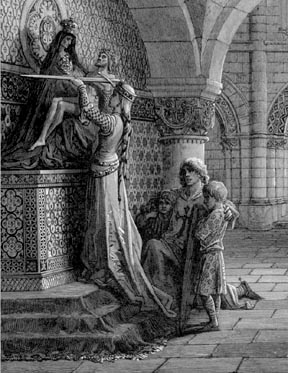Some time ago, I posted a poll about whether the proverb All is fair in love and war is true or not. At the time, I did not say that I was posting on the subject because it was part of my discussion in the paper I had been working on. In any case, most of you agreed with me.
That being said, I post below the introduction to the paper that I will be giving in about 20 minutes in Fatima. I will be reading an abbreviated version due to time constraints. More excerpts to follow.
*****
All is fair in love and war.
Traced back to the 16th century work, Euphues written by the Englishman John Lyly, this proverb expresses the rejection of the standard of fair play where matters of the greatest importance are concerned. It also conveys the paradox, or coincidence of opposites, concerning love and war, viz. that while the one connotes a state of peace and the other conflict, the two are never really far apart. In fact, the very Prince of Peace came not to bring peace, but to bring the sword. In other words, the unity of love is never attained by man after the Fall without conflict. On the cross, Christ is both Warrior and Bridegroom.
But the question is whether or not “all” is really fair in love and war. It seems to me, in this respect Lyly’s proverb is more or less in accord with the present zeitgeist. At least there is no universally accepted standard by which to determine what, in the main, the common good actually is, so we bump around in the dark until we arrive at some measure of tolerance for one another—a very utilitarian standard of fair play, indeed. The very same feminists, for example, who in the 1960’s and 70’s wished to deliver themselves from the disparity of subjugation to men as sex objects and insisted on birth-control and abortion in order to accomplish this, now affirm their right to be sex objects as long as they are in control and have something to gain. Birth-control and abortion have assured that everyone gets what they want, everyone, that is, except the victims of the silent holocaust. In this way, without an objective measure of fair play, the battle of the sexes has reached a sort of precarious détente, which some of us might argue is more like the threat of “mutually assured destruction.”
Cervantes took up the proverb and put it on the lips of Don Quixote who finds himself breaking up a brawl caused by an absurd romantic trick. The maiden Quiteria has consented to marry the rich Camacho solely for his wealth and in so doing jilts her true love Basilio. At the wedding before the vows have been exchanged, Basilio shows up and throws himself upon his own rapier in front of the wedding couple. As he lay dying, Basilio refuses to confess to the priest unless Quiteria agrees to marry him. As soon as he has obtained her consent Basilio jumps to his feet and reveals his “suicide” to be a trick, and in spite of the deceit Quiteria remains firm in her intention to have him. A brawl between the parties of Camacho and Basilio ensue and Quixote intervenes, crying:
“Hold, sirs, hold! . . . we have no right to take vengeance for wrongs that love may do to us: remember love and war are the same thing, and as in war it is allowable and common to make use of wiles and stratagems to overcome the enemy, so in the contests and rivalries of love the tricks and devices employed to attain the desired end are justifiable, provided they be not to the discredit or dishonour of the loved object.
Cervantes never tires in poking fun at the literature of chivalry, which often promulgated a code of ethics for love and war that mandated contradictory behavior; Don Quixote speaks of rights but in the same breath denies rules of fair play. In fact, foolish, romantic sentimentalism by definition discredits and dishonors the loved object.
But it is not only the fictional literature of chivalry that reveals the contradiction. The 12th century work In The Art of Courtly Love by Andreas Capellanus, written at the request of the Marie de Champagne, daughter of Eleanor of Aquitaine and followed by many of the courtiers of Europe, we are given an adulterous mandate as the first rule of love: “Marriage is no real excuse for not loving.” Then, having said this, Capellanus absurdly exhorts his readers that they should “be mindful to completely avoid falsehood.” So much for the Lancelots and Guineveres of the world.
But love and war have always been pretty much the same thing, at least since the Fall. God created Man, male and female. Marriage is the first sacrament established by God. Theologians call it a sacrament of nature. In America, where the battle over same-sex marriage rages (more love and war), the proponents of sodomy assert that it is solely the State, not the Church, that creates and has the right to define and regulate marriage. In fact, marriage arises from neither the Church nor the State. Marriage exists because man is male and female; it is a sacrament of nature. Both the Church and the State take in interest in marriage because it is a fundamental good for both, but it pre-exists both the Church and the State. (Relative to the Church, of course, the solemnization of the union is also Sacrament of the New Testament established by Christ, but that does not change the fact that neither the Church nor the State has created marriage).
Again, without universal standards we bump around in the dark unable to perceive any objective definition of our fundamental institutions and settle on dogmatizing a standard of tolerance which is intolerant of everything but tolerance. Nothing has really changed since the garden of paradise. Fallen man is still a usurper. He reaches out for love, but by denying the source of love the result is war.
The temptation of the serpent is an act of consummate violence. The sin of our first parents is an arrogant and petty assault on heaven. The subsequent history of mankind is a family feud, whose body-count is virtually numberless. The primordial prophecy and promise of our redemption reveals that human history will be the recounting of a nearly endless war, in which finally victory will only come at the end of the world, when the Immaculate foot of the Woman will have stamped out the last efforts of the serpent to win over souls to his lie. The Father of Lies knows of no code of ethics in regard to either love or war. And from his point of view, love and war are the same because lust and hatred are espoused in the darkling rites of the netherworld. But, in some sense, they are the same also from God’s point of view because both courtesy and courage will be forever united by the bond of a brotherhood in arms against all that is godless.
Our first and fallen parents are types of the new man and woman, by which the rest of us are recreated—not only in the image of God, but also in the image of the new and true Adam and Eve. Christ and Our Lady are the new couple, the heads of the new family that is the Church. Their story is an adventure of the most epic proportions and it concerns entirely the working out of ultimate love and ultimate war. If we are honest we will have to admit that our salvation is all about love, but it is also all about war. There is no use in living in denial, by pretending that some fuzzy and warm concept of the universal brotherhood of man will save us, but neither will we get away with fighting our way out of the mess we are in without a code of warfare. Love and war are close allies, but all is not fair in love and war.




